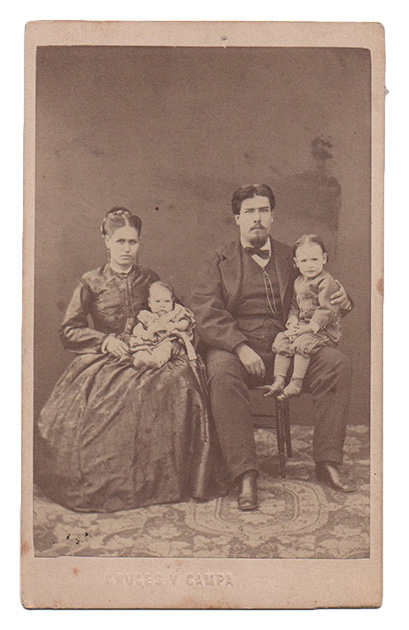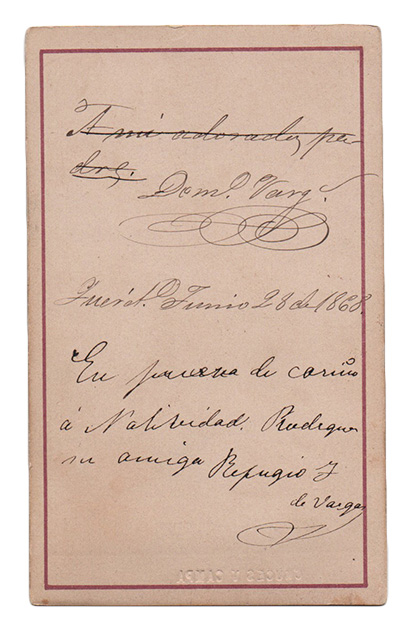IN FAMILY
Family photo. Mexico City. Circa 1865.
Vintage copy on albumen paper, in “carte-de-visite” format. Measures. Photograph: 9.2 x 6.1 cm. Secondary support: 10.6 x 6.3 cm. Advertising: Dry stamp on the front of the cardboard and on its lower edge: "Crosses and Campa". Work in good condition.
The irruption of the revolutionary business card or "carte-de-visite", gave way to a true social "cartomania", where a multitude of eager clients were able to access a dozen portraits for the first time, and at prices much lower than a daguerreotype. This technical innovation changed the rules of the game of the nascent universal photography; its demand increased, new photographers dedicated to the "carte-de-visite" emerged and the photographic album was born to contain that growing iconography. In turn, the small portraits on cardboard made it possible to write dedications on the back and it was even possible to send these thin images by post to any destination in the world.
Mexico was not immune to these changes and its capital was populated with new establishments devoted to the popular modality. Among all of them, the firm "Cruces y Campa" clearly stood out for the quality of its work. That company name was formed from the year 1862 by the photographer Antioco Cruces and the engraving professor Luis Campa, first with premises on San Francisco street and then on Empedralillo street, next to the Metropolitan Cathedral. They achieved special prestige by publishing a complete iconographic collection on Mexican leaders, although their most significant contribution was the series of popular types of notable artistic and documentary richness.
Regarding the studio portrait that concerns us, we will say that the attendance of this bourgeois family at the gallery of the Cruces y Campa studio was not a fortuitous decision because -as the historian Miguel Ángel Cuarterolo pointed out- the visit to the photographer was due to the commemoration of an important marital event, such as the birth of the youngest girl and, consequently, the gift to close relatives and friends of these dozen portraits.
At this point we must transcribe the double dedication on the back. In the upper part and handwritten in black ink it indicates: "To my adored father (text crossed out) Daniel Vargas. Querét (aro). June 28, 1868". While her wife reuses the same business card and writes below: "In proof of affection to Natividad Rodríguez, her friend. Refugio J. de Vargas"
In that Pose Gallery with its neutral backdrop and flowery carpet is the whole family; everyone wears their best clothes; the wife with a wide skirt of dark silk supported by a stiff hoop skirt and bandeau hairdo; the husband suit with waistcoat, bow tie, boots and flashy gold pocket watch chain. The immobility mechanisms ordered by the photographer are fulfilled "to the letter", with both parents sitting and holding the children, while the metal headrests are hidden from view.
The group posed motionless for the long seconds of repeated shots, their fascinated eyes staring into the multiple camera of brilliant lenses.
In Memory of Enrique Fernandez Ledesma. Author of the book "The Grace of Ancient Portraits" (1950)
By Abel Alexander
President of the Ibero-American Society for the History of Photography
| AUTHOR | CRUCES Y CAMPA |
|---|
Are you interested in selling some works?
Send us an email briefly indicating
which works you intend to put on sale, and we will respond. click here
Subscribe to our newsletter to be updated.
Check our Newsletters
